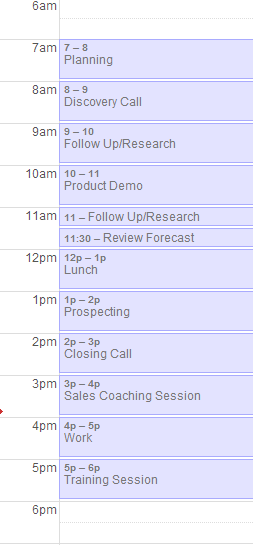

Daily Habits of a Highly Effective Sales Rep
What does a successful quota-carrying sales rep do every day? It’s no shock to learn that the best reps in the business are incredibly focused, organized, and clearly plan out each day with a set goal in mind.
Here I wanted to share what I believe to be some highly-effective activities of my team’s best Inside Sales Reps. Keep in mind that every day is different and this is just a generalized example, but these are the types of sales activities you’d want to see your sales reps do throughout their week. There will always be breaks in between meetings and this isn’t a representative of each day, day-in and day-out. A number of these examples are based on my personal experiences throughout my sales career both as a quota-carrying sales rep at IBM and as a sales executive running OEM Sales at Acronis, as well as global sales at StarWind Software and here at InsightSquared.
Oh, and by the way, you may be surprised to see a 5:30 am wake up below and I certainly can’t expect everyone to wake up that early but I like to remind everyone what Benjamin Franklin said, “Early to bed, early to rise, makes a man healthy, wealthy and wise.”
The Day of a Highly Effective Sales Rep
5:30 am –
Wake up, get a good workout to get some energy for the day, have breakfast.
7:00 am –
Get into the office early. Begin to plan out my day. Understand my appointments for the day and create a plan for each. Prepare thoroughly. Review the opportunities in my sales pipeline that I need to work on to hit my number this month.
8:00 am –
First call of the day – a discovery call. Talk to the prospect about her business pain, what her challenges are and understand if our product can solve her headaches. Ask questions. Listen actively, talk less and listen more. Schedule next steps and a follow-up call before getting off the phone.
9:00 am –
Take this time to write a follow-up email (the Champion Letter) to the prospect I just spoke with, summarizing the main takeaways and confirming the business pain and that we can indeed solve it. Summarize the next steps too, including a calendar invite confirming the upcoming meeting. Input the notes and data from the call into Salesforce.com, including all the information necessary to track my opportunity’s progress. Then move onto preparing for my next call at 10, researching the new prospect and reviewing what I need to accomplish.
10:00 am –
This is my first product demo of the day for an interested prospect with whom I did a discovery call last week. Start off the call by asking a number of questions confirming his business challenges. Begin to present only those aspects of the product that directly link to solving those business pains. I don’t talk about features and I don’t offer random things hoping that they stick. I only work off of the responses of the prospect, showing the relevant aspects of the product and explaining how they solve the pain points mentioned by the prospect. I end the call by discussing next steps, and scheduling the next meeting with the prospect if he’s interested.
11:00 am
As I do with all of my calls, I write a follow-up email to the prospect, again summarizing what we discussed and confirming what we agreed about the next steps. And obviously, I input all my notes into Salesforce. If during this call we met the exit criteria of the opportunity’s current stage (per our sales process), then I will change the opportunity stage in the CRM. Now my forecast will apply a higher probability of % Win Rate from this stage to Closed-Won, and the expected value of my forecast for the month is higher. I feel the day started well.
11:30 am
I do a quick review of my personal sales forecast for the month, taking a look at how my opportunities are progressing down the sales pipeline so far. I assess which opportunities should have stages adjusted in the forecast because they will close sooner, or later, or won’t close at all. This helps me know my business, and not knowing your business is the cardinal sin in sales.
Also, I notify my manager of the changes to the forecast based on my previous call, as I want to communicate this in real-time. I never want to surprise my sales manager with news at the end of the month, whether good or bad.
12:00 pm –
Grab lunch with others in the office. I never eat lunch alone, so I catch up with people from marketing and product to see what’s happening across the company. Sales is a contact sport and I am all about connecting with people in the office too (after all, it’s important for teamwork and who knows if someone can refer a friend as a prospect). After a 30 minute lunch, I also take a stroll outside to catch some fresh air, break up the day, and get ready for the second half of the day.
1:00 pm –
For an hour, I focus on strategic prospecting activities. Prospecting for quota-carrying reps is different than what junior Sales Development Reps do. This is not just cold calling – I prospect by calling existing customers to check on them and ask for referrals. I also do some social selling through new connections on LinkedIn. Finally, I reach out to my Closed-Lost opportunities and try to revive them. This type of prospecting is necessary because my quota is entirely my responsibility and – whether I get enough marketing leads or not – I will prospect hard to hit my number.
2:00 pm –
I have a call to work a late stage opportunity. We are getting closer to the finish line on this particular opportunity and will be discussing the prospect’s buying process and doing a final negotiation. During the call we discuss who puts pen to paper and if their CFO has any remaining questions about pricing so that’s not a blocker for us. We also cover any legal questions in our Terms & Conditions document. The prospect keeps asking for a discount throughout the call, but I explain we don’t give unilateral concessions. In the end we negotiate a win-win by giving a little discount in return for a prospect signing up for not just one, but three years. Finish the call with solid next steps to ensure the deal is closed before the end of tomorrow.
3:00 pm –
Meet with my manager for personalized, one-on-one sales coaching. This session is focused on improving my product demo skills. My manager listens to a recording of one of my demos, we analyze what went well and what could be improved. We role play. We discuss the next session, which will work on a different sales skill. We also immediately schedule the next sales coaching meeting next week. My manager and I spend at least a few hours a week in coaching meetings, which are in addition to our team-wide training. These coaching sessions are extremely helpful and I prepare for them each time so that they can help me become more effective in my job.
4:00 pm –
I get a copy of a new eBook from my marketing team, which has great thought leadership that will be interesting to my prospects. I forward it to many of my new prospects because my philosophy in sales is “Always be Helping” and I try to educate them to build bonds, rapport and my own credibility as a trusted adviser. This strategy helps me win deals.
During this time I also help a new sales rep who had some questions. I enjoy helping others on my team – we have a great culture, great chemistry and we learn from each other.
5:00 pm –
I join the entire sales team in a group training session on this week’s topic, which is about new product features and how to position them in our demos when needed. These training sessions are different from coaching and it’s another tool in our sales toolbox to help us be more effective as sales professionals.
6:00 pm –
Finish up a few odds and ends before I leave for the day. I take time to analyze what happened over the course of the day, review my own sales metrics and then I head home.
8:00 pm –
At home, after dinner, the work hasn’t quite stopped. I pick up a book from the list of the top 10 sales books from 2014. The most successful sales professionals are always reading to educate themselves and improve their game. I never stop learning. I want to be the best in my job.
As you can see, a successful sales rep is always planning, always strategizing, and always learning. So what does your day look like?

